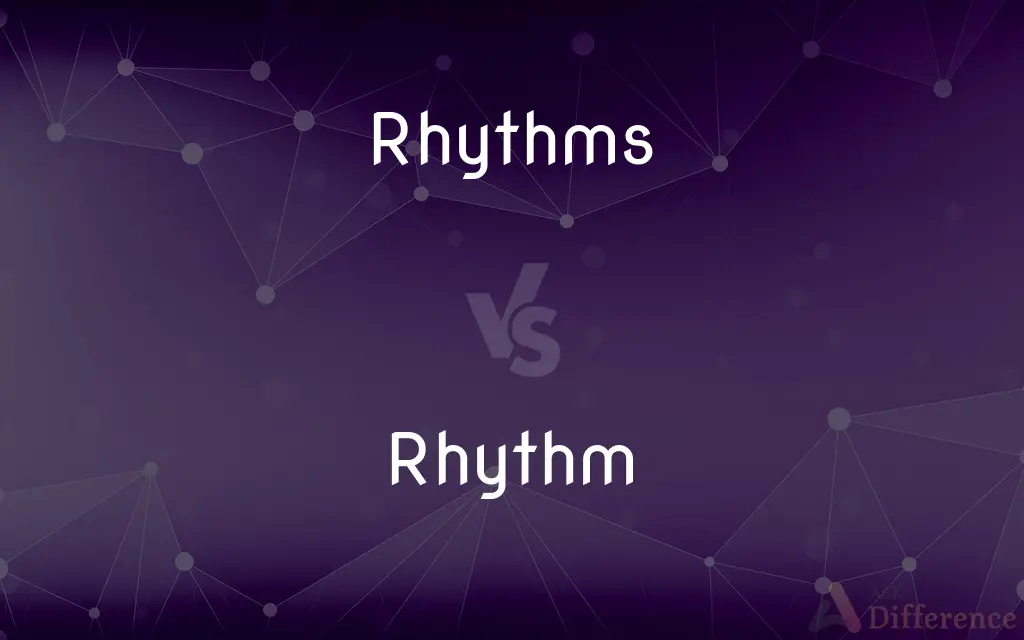Rhythms vs. Rhythm — What's the Difference?
By Fiza Rafique & Urooj Arif — Updated on February 21, 2024
"Rhythm" refers to a patterned recurrence of elements in time, crucial in music and poetry, while "rhythms" is simply the plural form, indicating multiple such patterns or types.

Difference Between Rhythms and Rhythm
Table of Contents
ADVERTISEMENT
Key Differences
Rhythm, in its singular form, emphasizes the concept of a single, cohesive pattern of beats, sounds, or movements that occur in a structured, recurring manner, such as the rhythm of a song or a poem.
When we use "rhythms," we're referring to a variety of these patterns or types within a context, such as exploring the diverse rhythms found in different musical genres or cultural dances.
The distinction also highlights the scope of discussion: "rhythm" might be used when focusing on the specific pattern within a piece, whereas "rhythms" suggests a broader examination of multiple patterns or styles.
In teaching or analysis, "rhythm" could be used to introduce the foundational concept, while "rhythms" might come into play when comparing and contrasting different examples or traditions.
Understanding the singular and plural forms is crucial in accurately conveying the extent and variety of rhythmic patterns in any artistic, biological, or physical context, from music and poetry to the rhythms of the natural world.
ADVERTISEMENT
Comparison Chart
Definition
A patterned recurrence of a beat, sound, or movement in time.
Multiple patterns or types of such recurrences.
Scope
Refers to a single, cohesive pattern.
Indicates variety or multiple instances.
Usage Context
Specific analysis or focus on one pattern.
Broad examination or comparison of patterns.
Example in Music
The rhythm of a particular song.
The various rhythms in jazz music.
Example in Nature
The rhythm of the ocean waves.
The rhythms of different ecosystems' life cycles.
Compare with Definitions
Rhythms
A structured beat in music.
The song's rhythm got everyone dancing.
Rhythm
Varied musical patterns.
The composer experimented with different rhythms.
Rhythms
Regular movement pattern.
The rhythm of her walk was captivating.
Rhythm
Poetic styles.
His poetry incorporates diverse rhythms.
Rhythms
Natural occurrences.
The rhythm of the seasons influences agriculture.
Rhythm
Seasonal changes.
The rhythms of the rainforest dictate the life within.
Rhythms
The pattern in poetry.
The poem's rhythm enhanced its emotional impact.
Rhythm
Movement variations.
The dancers showcased rhythms from around the world.
Rhythms
Biological cycles.
The circadian rhythm regulates sleep-wake cycles.
Rhythm
Multiple biological cycles.
Studying the rhythms of nature reveals ecological insights.
Rhythms
Movement or variation characterized by the regular recurrence or alternation of different quantities or conditions
The rhythm of the tides.
Rhythm
Rhythm (from Greek ῥυθμός, rhythmos, "any regular recurring motion, symmetry"—Liddell and Scott 1996) generally means a "movement marked by the regulated succession of strong and weak elements, or of opposite or different conditions" (Anon. 1971, 2537).
Rhythms
Plural of rhythm.
Rhythm
The pattern or flow of sound created by the arrangement of stressed and unstressed syllables in accentual verse or of long and short syllables in quantitative verse.
Rhythms
The pattern of development produced in a literary or dramatic work by repetition of elements such as words, phrases, incidents, themes, images, and symbols.
Rhythm
The pattern of development produced in a literary or dramatic work by repetition of elements such as words, phrases, incidents, themes, images, and symbols.
Rhythms
The pattern or flow of sound created by the arrangement of stressed and unstressed syllables in accentual verse or of long and short syllables in quantitative verse.
Rhythm
Movement or variation characterized by the regular recurrence or alternation of different quantities or conditions
The rhythm of the tides.
Rhythm
Movement in musical time, with periodical recurrence of accent; the measured beat or pulse which marks the character and expression of the music; symmetry of movement and accent.
Common Curiosities
Why is rhythm important in poetry?
Rhythm in poetry helps to create structure, enhance meaning, and evoke emotions, contributing to the overall impact of the poem.
How do rhythms vary in music?
Rhythms in music can vary widely, from the simple beats of a pop song to the complex patterns found in classical compositions or jazz improvisations.
What is the basic definition of rhythm?
Rhythm is the patterned recurrence of elements in time, fundamental in music, poetry, and various natural phenomena.
Can a single piece have multiple rhythms?
Yes, a single piece of music or dance can incorporate multiple rhythms, creating a complex and rich experience.
What's the difference between rhythm and tempo?
Rhythm refers to the pattern of beats, while tempo specifies the speed at which those beats occur.
How does rhythm relate to daily life?
Rhythm is present in daily life through regular patterns and cycles, such as sleep-wake cycles, heartbeats, and even routine activities.
Can rhythm affect mood and emotions?
Yes, the rhythm of music, poetry, or even natural sounds can significantly influence human mood and emotions.
How do artists use rhythm in their work?
Artists use rhythm to create patterns, emphasize certain elements, and guide the viewer's or listener's experience through their work.
What role do rhythms play in nature?
Rhythms in nature, like day and night cycles or seasonal changes, are crucial for the timing of ecological processes and the survival of organisms.
Can rhythm be found in visual arts?
Rhythm can also be found in visual arts through the repetition of visual elements, creating movement and harmony within the artwork.
Is understanding rhythm important for learning music?
Understanding rhythm is fundamental in learning music, as it is essential for timing, coordination, and expression in musical performance.
How can one improve their sense of rhythm?
Improving rhythm can involve practices like clapping along to beats, using a metronome, or learning to play a musical instrument.
Do languages have rhythms?
Yes, languages have rhythms created by the patterns of stressed and unstressed syllables, affecting speech flow and accent.
How do rhythms contribute to cultural identity?
Rhythms contribute to cultural identity through traditional music, dance, and rituals, reflecting a community's history, values, and social fabric.
Are rhythms in nature always consistent?
While many natural rhythms like day-night cycles are consistent, others can vary due to environmental changes or human influences.
Share Your Discovery

Previous Comparison
Mwahaha vs. Muahahaha
Next Comparison
Connote vs. DenoteAuthor Spotlight
Written by
Fiza RafiqueFiza Rafique is a skilled content writer at AskDifference.com, where she meticulously refines and enhances written pieces. Drawing from her vast editorial expertise, Fiza ensures clarity, accuracy, and precision in every article. Passionate about language, she continually seeks to elevate the quality of content for readers worldwide.
Co-written by
Urooj ArifUrooj is a skilled content writer at Ask Difference, known for her exceptional ability to simplify complex topics into engaging and informative content. With a passion for research and a flair for clear, concise writing, she consistently delivers articles that resonate with our diverse audience.
















































